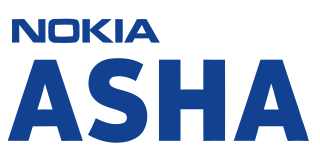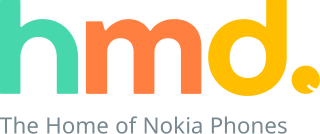Series 40, often shortened as S40, is a software platform and application user interface (UI) software on Nokia's broad range of mid-tier feature phones, as well as on some of the Vertu line of luxury phones. It was one of the world's most widely used mobile phone platforms and found in hundreds of millions of devices. Nokia announced on 25 January 2012 that the company has sold over 1.5 billion Series 40 devices. They are not used for smartphones, in which Nokia primarily uses Windows Phone and, until 2012, Symbian. However, in 2012 and 2013, several Series 40 phones from the Asha line, such as the 308, 309 and 311, were advertised as "smartphones" although they do not actually support smartphone features like multitasking or a fully fledged HTML browser.

The Nokia 6120 classic is a mid-range smartphone from Nokia that was announced on April 17, 2007. It runs on Symbian v9.2 with a S60 3rd Edition FP1 user interface.
The Nokia 1011 is the first mass-produced GSM phone. It was sold also as Mobira Cityman 2000. The typenumber refers to the launch date, 10 November 1992.

The Nokia 2630, released in Q2 2007, is a mobile phone developed by Nokia.

Nokia Nseries was a multimedia smartphone and tablet product family engineered and marketed by the Nokia Corporation. The Nseries devices commonly supported multiple high-speed wireless technologies, such as 3G, or Wireless LAN. Digital multimedia services, such as music playback, photo/video capture or viewing, gaming or internet services were also supported. The line was replaced in 2011 by the Nokia Lumia line as the company's flagship smartphone portfolio.
Nokia's strategic nomenclature can be traced back in 2005 when the Nseries line was launched, offering devices with flagship specifications and premium hardware at various price points. These devices were considered the "bread and butter" of the company and were often positioned to showcase their latest technologies. Thanks to the newfound consumer and enterprise interest in smartphones at the time, the company introduced four additional collections to diversify their product portfolio and meet demands in most market segments. These new phone series were named Eseries, targeting small business and enterprise customers; Xseries, providing consumer-grade multimedia-focused devices; Cseries, which Nokia used to target both the low-end and mid-range market segments; and Tseries, for devices exclusive to the Chinese market.

Microsoft Lumia is a discontinued line of mobile devices that was originally designed and marketed by Nokia and later by Microsoft Mobile. Introduced in November 2011, the line was the result of a long-term partnership between Nokia and Microsoft—as such, Lumia smartphones run on Microsoft software, the Windows Phone operating system; and later the newer Windows 10 Mobile. The Lumia name is derived from the partitive plural form of the Finnish word lumi, meaning "snow".

The Nokia Asha 200 & Nokia Asha 201 are budget-level additions to the Nokia Asha family released in Q4 2011. Both devices run the Nokia S40 mobile operating system. There is no direct predecessor of the phones, though the closest to it is the Nokia X2-01, which has similar features and a very similar user interface, as well as having better music capabilities. The Nokia C3 is also an indirect predecessor, also using similar features, though the C3 is a higher end device. The phones are successors to the Nokia X1-01, as they use the same bright colors and the same Dual SIM support for Nokia Asha 200.

The Nokia Asha series was a range of low-end
feature phones produced and marketed by Nokia. The name "Asha" came from the Hindi word meaning "hope".

Nokia 100 is a basic 2G feature phone released by Nokia on 25 August 2011. The mobile phone is aimed at emerging markets and budget-conscious consumers, and can be bought carrier-unlocked for a relatively low price.

The Nokia XL is a smartphone announced as part of the Nokia X family in February 2014, running on the Nokia X platform. It is currently sold and maintained by Microsoft Mobile.

The Nokia X family was a range of smartphones that was produced and marketed by Microsoft Mobile, originally introduced in February 2014 by Nokia. The smartphones run on the Nokia X platform, a Linux-based operating system which was a fork of Android. Nokia X is also a model of phone, known generally as the Nokia Normandy. The first Android device Nokia made, and came as a surprise as the company was in its Microsoft partnership and was in the process of selling its mobile phone business to Microsoft, which eventually happened two months later.

Microsoft Mobile was a subsidiary of Microsoft involved in the development and manufacturing of mobile phones. Based in Espoo, Finland, it was established in 2014 following the acquisition of Nokia's Devices and Services division by Microsoft in a deal valued at €5.4 billion, which was completed in April 2014. Nokia's then-CEO, Stephen Elop, joined Microsoft as president of its Devices division following the acquisition, and the acquisition was part of Steve Ballmer's strategy to turn Microsoft into a "devices and services" company. Under a 10-year licensing agreement, Microsoft Mobile held rights to sell feature phones running the S30+ platform under the Nokia brand.
Nokia 3710 is a feature phone manufactured by Nokia. It was announced by Nokia on June 2009 and released in December of that year. It was hailed as the direct successor to the Nokia 3610 fold, the previous model launched at the end of 2008.It was being the last flip phone ever by Nokia, as it no longer produces them since 2011.

The Nokia 215 is a Nokia dual-band GSM feature phone by Microsoft Mobile. The phone is available in black, white, and bright green.
The Nokia 3-digit series are a series of feature and smartphones by HMD Global and previously by Microsoft Mobile and Nokia, generally aimed at developing markets.

Series 30+ is a software platform and application user interface used for Nokia-branded mobile devices. The platform was introduced by Nokia in September 2013, first appearing on the Nokia 108, and has been the main Nokia feature phone operating system after the end of the Series 30 and Series 40 platforms in 2014. Despite the similar name and user interface, S30+ is technically completely different and unrelated to S30.

HMD Global Oy, branded as HMD, is a Finnish mobile phone company, made up of the mobile phone business that Nokia had sold to Microsoft in 2014, then bought back in 2016. HMD Oy began marketing smartphones and feature phones under the Nokia brand on 1 December 2016. The company has exclusive rights to the Nokia brand for mobile phones through a licensing agreement. The company was created by inheriting Microsoft Mobile's feature phone business, which was sold by Nokia in 2014. They are in a "close partnership" with Google and use the Android software on their smartphones, whereas on their feature phones the Series 30+ platform is mainly used. The HMD brand is only used for corporate purposes and does not appear in advertising, whereas the name Nokia Mobile is used on social media.















